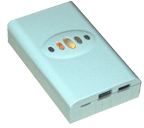Fireflies: An apparatus for continuously sensing human activities
Mik Lamming, Firefly
Labs
mik![]() firefly-labs.com
firefly-labs.com
Seminar on People, Computers,
and Design
The work of medical researchers, scientists, architects, designers, and marketeers
frequently involves collecting and analyzing the detailed activity data gathered
from the everyday lives of test subjects.

Firefly Labs is developing a system of hardware and software to automatically
sense and gather human activity data. Fireflies are small (64 x 36 x
18 mm) battery powered wireless sensors, explicitly designed from the ground
up for behavioral sensing applications. A set of Fireflies can be deployed
in a few minutes. They can be put in a pocket, attached to things, or
put in places.
 The
data they collaborate to produce can be used in real-time to spot situations
of interest, or concern, or compiled into a human understandable biography.
Compared with manual techniques, our sensing system can gather more consistent
data, over longer periods (24x7), without interruption or intervention, resulting
in higher quality data and lower total cost.
The
data they collaborate to produce can be used in real-time to spot situations
of interest, or concern, or compiled into a human understandable biography.
Compared with manual techniques, our sensing system can gather more consistent
data, over longer periods (24x7), without interruption or intervention, resulting
in higher quality data and lower total cost.
One of the applications we are investigating is elderly care, and there are
many others.
![]()
Mik Lamming is exploring how swarms of tiny wireless sensors, called Fireflies, can continuously monitor long-term human behavior, but without compromising privacy.
In the '80s, at Xerox PARC, Mik glimpsed a prototype electronic still camera. Betting on the imminent arrival of consumer digital cameras, he built Digital Darkroom, a precursor to PhotoShop. In '90s he helped found Xerox EuroPARC, and built the Ubiquitous Computing lab. establishing many of the fundamental patents in the field. His team prototyped Forget-me-not a portable memory aid, and spun out a company to market Satchel, a tiny ubiquitous document access device. With William Newman is author of the textbook "Interactive System Design".
In 2005 he co-founded Firefly Labs
to develop ground-breaking behavioral sensing products and services.
![]()
View this talk on line at CS547 on Stanford OnLine
Titles and abstracts for previous years are available by year and by speaker.